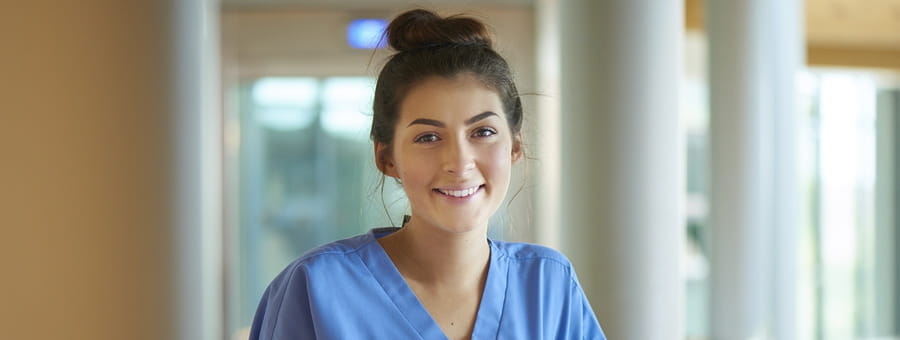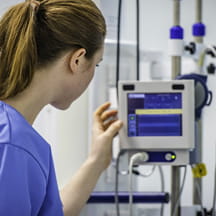Hospital Creates Linear Path to Competency for New Nurses

“This new generation of nurses is always looking for feedback, growth and a direction to move forward in,” says Melinda Pascual, BSN, RN, CPN, manager of Clinical Education and Professional Development at Children’s Hospital of Orange County (CHOC). “They have shown great interest in the plan we have created for them.”
Pascual and colleagues created a phased program for CHOC's new nurses transitioning to practice. Helping new nurses reach competence in patient and clinical care, this 24-month program incorporates the tenets of Patricia Benner's "Novice to Expert" theory and Bloom's Taxonomy.
“These theories line up very nicely with our clinical ladder,” Pascual says. “Marrying these theories as well as using our competency tools, we constructed a curriculum around knowledge, skills and abilities that were appropriate for novice residents.”
Finding the knowledge gaps
The CHOC team began by restructuring their nurse residency curriculum, which allowed them to identify gaps in knowledge and skills in the program. These gaps included:
- Knowledge deficits in assessment, understanding patient populations, anticipatory critical thinking and time management.
- An increase in medication errors, which were mitigated with more frequent check-ins and daily forms.
- Retention and turnover issues related to stress and performance, exacerbated by the COVID-19 pandemic, which increased anxiety and limited opportunities for new nurses to learn in a clinical environment.
A closer look at these issues led the team to revamp and add to their existing training programs, creating three programs through which nurses can navigate as they finish school and move into practice.
Transition into practice
CHOC’s Transition to Practice (TIP) program ensures all students meet 132 clinical hours and complete a standard CHOC-specific curriculum.
“The goal was to allow students with an interest in pediatrics the opportunity to have that exposure and a targeted curriculum that meets both academic and CHOC objectives,” Pascual says. “This better prepared our students who were accepted into the residency program to have a stronger foundation.”
The program now consists of 11 shifts, a mixed modality of web-based training and an observation checklist which serves as a skill evaluation that preceptors sign off on as students demonstrate each skill. Pre- and post- tests and self-analyses allow CHOC to track progress throughout the program.
Graduate nurse program
While the TIP students focus on foundational pediatric concepts, the graduate nurses focus on tasks.
This program, available for newly licensed nurses who are not yet in the residency program, provides graduate nurses with the opportunity to build skills and gain exposure to the organization, unit culture and role of an RN at a pediatric acute care hospital.
“We put them in a team nursing model so none of our graduate nurses have their own patient assignments,” Pascual says. “But they're delegated tasks from their partner nurses that can't be delegated to our nurse assistants, and they can also assist in monitoring patients.”
Each unit has a list of “graduate dos and don’ts” to outline tasks graduate nurses can work on and the the level of supervision needed depending on patient acuity. Under the Blooms and Benner theories, this approach allows the graduate nurses to gain exposure that would better prepare them for the residency program.
“When they came into the residency, they could tie their experiences to better cognitively process the information that we were giving them,” Pascual says.
Registered nurse residency
The final stage of the transition to practice timeline, CHOC’s residency program, is a 16-month process including:
- Didactic classes and clinical preceptorship with group mentoring, debriefing sessions and progress meetings during the first 17 weeks.
- Independent clinical practice with one-on-one mentorship and a six-month post-preceptorship class followed by more time under a preceptor with higher acuity patients.
- Independent clinical practice opportunities.
- Final 16-month class and completion of the program.
Class time and clinical time are interwoven in this phase and while most of the didactic classes are covered in the first 17 weeks, more advanced topics are completed later. Residents are placed in the units early on so they can observe the unit’s culture helping them better understand the patient population.
“While these are actually separate programs from our residency, they all align to better train and prepare our nurses to be independent and competent by the end of the residency program,” Pascual says.
She also noted that at each new stage, the students are expected to apply for acceptance to the next program. Being a TIP student doesn’t guarantee them to be a graduate nurse or resident. This allows for self-reflection before continuing and helps to ensure this is the career path for them.
Pascual anticipates a variety of outcomes to this new approach, including increases in self-efficacy scores, increased retention, increased preceptor satisfaction and decreased performance-related issues.
About PLS
Pediatric Learning Solutions’ online education provides the foundational knowledge clinicians need to master the competencies and skills for safe and effective patient care.


